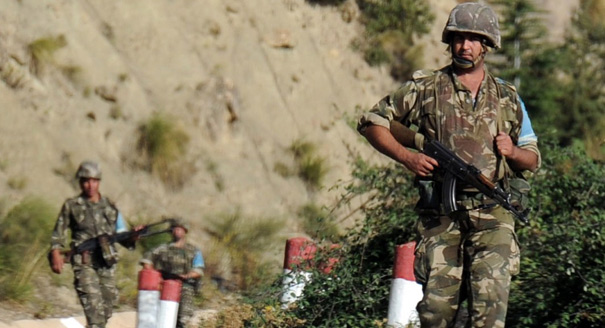On May 23, Algeria’s Defense Ministry announced it had captured 22 jihadists in less than two months. This followed the killing by the security forces of dozens of members of Al-Qaeda in the Islamic Maghreb (AQIM) since the beginning of 2018. Among the fatalities was Adel Seghiri, known as Abu Ruaha al-Qasantini, a senior Algerian operative responsible for the group’s propaganda. In AQIM’s historical stronghold of Kabylia, east of Algiers, the security forces also killed another important member, Bekkai Boualem, known as Khaled al-Mig, the organization’s head of external relations. In contrast, Heddad Fodhil, known as Abou Dedjana, who headed a local AQIM brigade, surrendered to the authorities.
AQIM has lost the areas it once controlled in Kabylia, the Berber heartland. This fact can be explained by the group’s extreme methods, its organizational woes, and repression by the state alongside its conciliatory policies toward repentant jihadists. AQIM has also lost key leaders and assets, and is finding it difficult to recruit militants as its ideology no longer seems to appeal to locals. Unable to pass on its dreams of an Algerian caliphate to a new generation of Algerians, the group has moved its operations toward the eastern part of the country, near the border with Tunisia. AQIM’s networks are likely to persist as the group has shown an ability to survive and conduct low-intensity attacks in Algeria. However, it remains a nuisance for the state, not an existential threat.
Even if AQIM is less extreme than one of its predecessors, the Armed Islamic Group, which fought in Algeria’s civil war, it managed to alienate the local population because of its harsh methods. When jihadi groups appeared in Kabylia during the 1990s, the population remained passive, even if it opposed their ideology. Because Berbers have always had a conflictual relationship with the central authorities in Algeria, which failed to address their resentments, a modus vivendi was established between the inhabitants of Kabylia and AQIM. This allowed the jihadi organization to strengthen its presence in the Berber hinterland.
However, this cohabitation would fall apart when AQIM started intimidating the local population to extract money and abducted or killed wealthy entrepreneurs in the region. Since 2005, AQIM is believed to have kidnapped more than 80 individuals. The constant insecurity hindered development and investment in Kabylia, aggravating an already unfavorable economic situation in the Berber provinces. In 2014, for example, the Chamber of Commerce and Industry of Tizi Ouzou Province reported that there were more than 71 cases of companies that had left Kabylia due to the absence of security. As a result, relations between locals and AQIM changed as the popular mood turned decisively against the group.
Another factor that contributed to AQIM’s reversals was its organizational woes. AQIM’s national emir in Algeria, Abdel Malek Droudkel, known as Abu Mus‘ab Abdelwadud, has been leading the group since 2004. In practice, however, Droudkel offers only guidance as AQIM’s multiple brigades remain autonomous when conducting their operations. Because of this separation, AQIM’s brigades often failed to communicate with one another or even provide their men with a minimal amount of material, weakening the group. Such an organizational structure hindered Droudkel’s leadership, negatively affecting AQIM as a whole.
A final reason for AQIM’s loss of its Berber stronghold was the tough, persistent counterterrorism measures adopted by the Algerian state. The kidnapping in September 2014 of French national Hervé Gourdel by Jund al-Khilafa fi Ard al-Jaza’ir, an AQIM splinter group that had defected to the Islamic State, was a tipping point. Gourdel’s killing a few days later led to a relentless manhunt and increased counterterrorism operations in the most remote redoubts of the Kabylia mountains. Between 2013 and 2018, such operations led to the killing of some 600 jihadists. The security forces, with the help of the Algerian intelligence services, also dismantled AQIM’s logistical networks. However, the state did not solely resort to violence. It also adopted conciliatory measures, particularly the Charter for Peace and National Reconciliation in 2005, which pushed hundreds of jihadists to surrender, sometimes in groups, sometimes with their families.
For all these reasons, AQIM has been unable to conduct any major attack in Algeria since the attack on a military convoy in ‘Ain Defla in 2015. Yet the group’s relocation east, to provinces such as Khenchla, Tebessa, Jijel, and Skikda, closer to the Tunisian border, had a limited impact, because the Algerian security forces and their Tunisian counterparts reinforced border security and collaborated on counterterrorism. They mounted several successful operations, with the latest one, in February 2018, leading to the killing of eight AQIM leaders in Khenchla. AQIM had hoped its move would allow it to unite its battalions and revive the dying Ukba bin Nafe‘ Brigade, an AQIM affiliate active in Tunisia, but this failed.
Given its limited manpower and organizational shortcomings today, AQIM’s prospects in Algeria seem limited. None of the organization’s goals in the country have been achieved. The government in Algiers continues to function, and those whom AQIM had described as tawaghit, or the impious, are still running the state. The prospect of establishing an Islamic state in Algeria now seems absurd. While AQIM’s end in Algeria may not be near, it also may not be so farfetched an idea either, as things stand. This is hardly unimportant, given the fundamental threat that the jihadists posed to the Algerian state not so very long ago.








